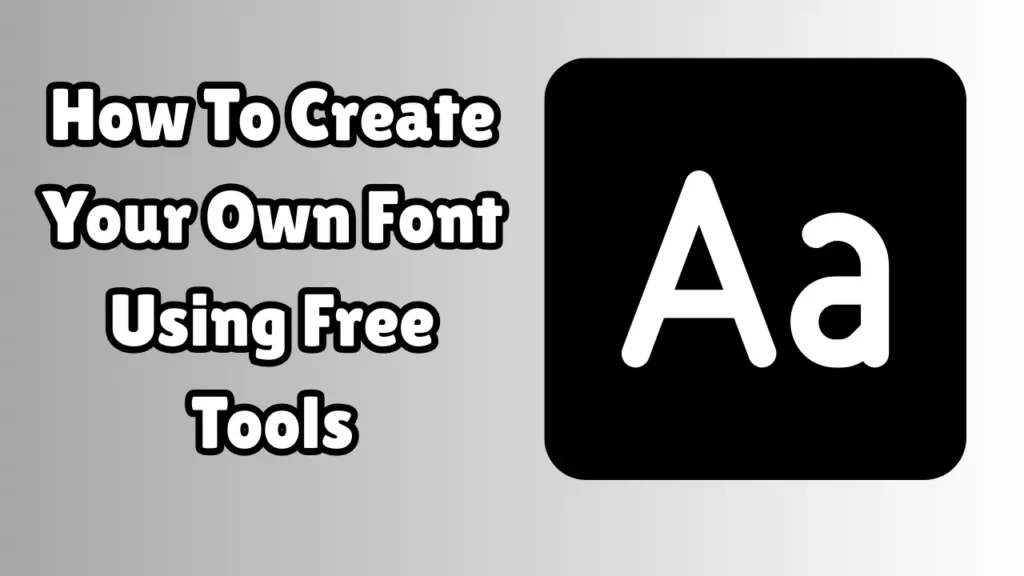How to Create Your Own Font Using Free Tools
Typography plays a crucial role in branding, design, and digital communication. Whether you’re a designer, artist, or creative entrepreneur, having your own custom font can elevate your personal brand and help your work stand out. The best part? You don’t need expensive software or technical expertise to create your own font in 2025. Thanks to several powerful free tools, anyone can design, customize, and use their own font.

In this comprehensive guide, you’ll learn how to create your own font from scratch using free tools, even if you’re a complete beginner.
1. Why Create Your Own Font?
Before diving into the how-to, let’s look at the benefits of creating your own font:
-
Brand identity: A unique font makes your branding instantly recognizable.
-
Creative expression: Add personality to your designs, websites, or merchandise.
-
Monetization: Sell your fonts on marketplaces like Creative Market or Etsy.
-
Customization: Tailor a typeface to suit specific projects or clients.
Whether you’re building a business, running a design agency, or just want to try something new, creating a font is a valuable and rewarding skill.
2. What You Need to Get Started
To create your own font, you’ll need:
-
A design or sketching tool (even pen and paper)
-
A font creation tool
-
Basic understanding of letterforms
-
Patience and creativity
You don’t need to be a calligrapher or typographer to start. Many font designers begin with hand-drawn letters or simple vector shapes.
3. Free Tools to Create Fonts
Here are the best free tools for font creation in 2025:
1. Calligraphr (https://www.calligraphr.com)
-
Great for beginners
-
Turns your handwriting into a font
-
Print and scan templates or draw digitally
-
Free version allows 75 characters
2. FontForge (https://fontforge.org)
-
Open-source, professional-grade tool
-
Offers vector editing, kerning, and advanced font features
-
Runs on Windows, Mac, and Linux
3. Glyphr Studio (https://www.glyphrstudio.com)
-
Web-based and free
-
User-friendly interface
-
Great for designing vector-based fonts from scratch
4. BirdFont (https://birdfont.org)
-
Desktop app with drawing tools
-
Import SVGs and create full fonts
-
Free for personal use
5. Vectr (https://vectr.com)
-
Free vector design tool (used to design individual letters before importing)
Pick the tool that matches your design style and comfort level.
4. Step-by-Step Guide to Creating Your Own Font
Step 1: Decide Your Font Style
Start with a concept. Will it be:
-
Handwritten or geometric?
-
Serif or sans-serif?
-
Display or body text?
Sketch or visualize how you want the letters to feel—bold, elegant, playful, techy, etc.
Step 2: Sketch Your Letters
You can either:
-
Draw by hand on paper and scan them, or
-
Use a drawing tablet or software like Krita, Vectr, or Inkscape
Focus on consistency in height, spacing, and shape across characters. Start with the alphabet (uppercase & lowercase), numbers (0–9), and basic punctuation.
Step 3: Digitize Your Letters
If you sketched by hand:
-
Use a scanner or take high-resolution photos
-
Upload your images to Calligraphr or use Inkscape to convert drawings to SVG
If you designed digitally:
-
Save each character as a separate vector (SVG) file or grouped graphic
Step 4: Import into a Font Editor
Use your selected font creation tool (e.g., FontForge or Glyphr Studio) to assemble the font.
In your font editor:
-
Assign each letter to its corresponding Unicode character
-
Align, scale, and position the letters using grid guides
-
Adjust spacing (side bearings) and kerning pairs for readability
Kerning ensures letters look naturally spaced in real words like “AV” or “To.”
Step 5: Test Your Font
Once your characters are in place:
-
Generate a test version of your font (.TTF or .OTF format)
-
Install it on your computer
-
Try it in a word processor or design app (e.g., Word, Canva, Photoshop)
Make adjustments as needed. You might find that some letters need resizing, shifting, or reshaping for better flow.
Step 6: Export Your Font
When you’re happy with the results:
-
Export the final version of your font
-
Save it in .TTF or .OTF format
-
You can now install it, share it, or sell it!
Each tool has an “Export” or “Generate Font” option. Make sure to test the exported font on multiple devices or apps to ensure compatibility.
5. Tips for Designing a Good Font
Here are some tips to make your font polished and professional:
Keep it consistent
Make sure strokes, spacing, and proportions match across all letters.
Focus on legibility
Avoid overly complex or decorative shapes unless you’re creating a display font.
Design the full character set
Include punctuation, accents, and numerals for versatility.
Name your font carefully
Use a unique, memorable name. Avoid using names similar to existing fonts.
Test with real text
Try typing sample sentences to see how the font performs in context.
6. Where to Use or Sell Your Font
Once your font is complete, you can use it in:
-
Branding and logos
-
Social media content
-
Print materials (flyers, posters)
-
Websites and digital products
Or, monetize your font by uploading it to:
-
Creative Market
-
Etsy
-
Gumroad
-
MyFonts
-
FontSpace (for free distribution)
Be sure to create a font preview image, demo text, and a license file to go with your font.
7. Legal Considerations
If you plan to distribute your font:
-
Create a clear license (free for personal use, commercial license, etc.)
-
Avoid copying other fonts—start from scratch or modify your own original artwork
Free font tools allow commercial use, but double-check their licensing terms, especially with tools like BirdFont or Calligraphr.
Conclusion
Creating your own font in 2025 is easier than ever, thanks to a growing ecosystem of free tools and intuitive platforms. You don’t need expensive software or a design degree—just creativity, patience, and attention to detail.